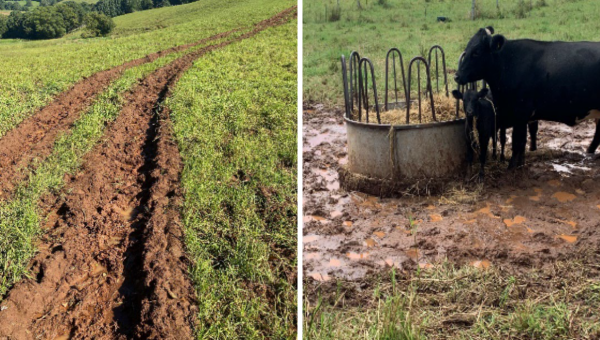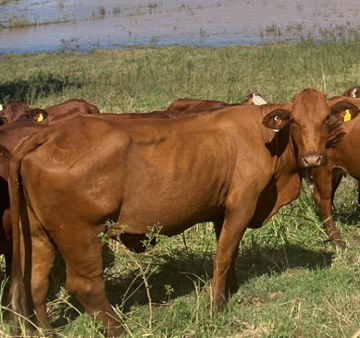Managing a small beef herd in wet conditions
On smaller holdings you may not have the option to move your stock to dry ground within the same property, own the required equipment to regularly feed your livestock or have access to the machinery required to support your livestock through a challenging season.
Often the person responsible for the cattle has competing time priorities which take them off-farm every day. This increases the challenges and associated costs per cow to manage a small herd through a tough season.
On the contrary, owners of smaller herds are often able to access alternative off-farm income. While this is a great benefit, the costs of feeding cattle over a long period can be very high and it is wise to consider this ongoing cost.
This article will guide you through some of the tips and considerations for managing a small beef herd through a challenging season.
Assess your budget for cattle feed
There are often many motivations for running cattle, and these may influence the choices you make. Getting a financial return may be less critical for those who see the animals as pets or hobbies, as opposed to the person running cattle as a business.
A landholder running cattle as a business may decide to agist the cattle out of the district or sell and wait for better seasonal conditions to return. A hobbyist may be prepared to spend large amounts of money to purchase feed and keep their animals at home.
Regardless of your motivation for running cattle, when it comes to handfeeding in an extremely wet year it is important to ensure you have a clear budget. Consider what you are prepared to spend on feed and ensure that you understand how much a feeding program could cost you. The next step is to think very critically about how practical it is to feed the number of cattle you have under such wet conditions.
Things to consider include how you will get the feed to your cattle each day, and whether the cattle will be able to access it safely and effectively:
- When cattle cannot reach feed without getting stuck in mud, they will eat less.
- Cattle lose as much body heat when covered in mud as they do from prolonged exposure to wind and rain. Discomfort makes cattle reluctant to eat.
- Mud increases the risk of contracting a number of diseases and infections, as well as common physical ailments such as lameness.
If you feel your budget won’t stretch far enough to cover feeding costs for all animals, then selling or agisting will help. You can potentially hold on to your better performing or favourite animals and keep them in good condition. However, there can still be a point when the season hasn’t improved, and you have reached your budget. The remaining cows you have been feeding may need to be sold or continue to be fed. Can you afford it? Long term feeding can become very costly.
For paddocks that are already heavily grazed it is unlikely there will be sufficient pasture recovery until late September or October in a typical year, meaning feeding is likely required for 5 to 6 months.
Agistment
Agistment is a popular option for landholders. This is a very sensible decision, and often works out far cheaper than a long-term feeding regime.
Agistment rates per head per week are variable depending on the class of cattle, the property, and its facilities. There will also be freight costs to and from the agistment property as well as fuel costs associated with trips to check the cattle. In comparison to fully hand feeding, agistment is almost certainly going to be a cheaper option.
If you are considering agistment then contact your stock agent and discuss opportunities with them. As winter approaches it becomes more difficult to locate agistment properties in some areas so acting early is advisable. As the western winter crops develop there are sometimes short term (2 – 3 months) agistment opportunities that arise, so it is worth contacting your agent to investigate.
Always use an agistment agreement. Agents and some landholders may be able to assist with this - having a written agreement can avoid issues down the track regarding length of tenure, payment terms and responsibilities of both parties.
Feeding cattle in wet conditions
When pasture levels are low, a decision must be made to either agist, sell or feed your cattle. If you decide to feed, you must ensure you have considered the practicalities of what is required. This is especially important if you have no pasture remaining on which your cattle can graze and you will be buying-in 100% of your animals' nutritional requirements.
Questions to ask yourself:
- What time do I have available?
- Full feeding can take a few hours a day, seven days a week.
- Bulk feeding equipment can reduce the time required but this comes at a cost and you are still required to check that animals are accessing the feed at appropriate rates.
- How can I provide the feed so that cattle can access it without excessive bogging? Or how frequently should I move the feeding system to prevent bogging issues?
- Where will I store large quantities of feed such as hay or grain?
- Do I have the machinery to handle large feed items such as round bales or bulk bags? Can this machinery access the feeding areas of where cattle are?
- Do I have feeders to prevent wastage of the feed?
- Do I know how to feed the product? Some feed sources such as grain can kill cattle if introduced too quickly. If you haven’t had experience with a particular feed, seek advice.
Access to paddocks by feeding machinery is an important consideration compared with agistment or selling stock.

Image 1 - Accessing paddocks to feed cattle may be challenging under wet conditions, causing extensive damage over time.
Image 2 - Using hay feeders helps reduce feed wastage. Wastage of hay bales without feeders can be as high as 20% or 64 kg (approx. equal to $28/bale wasted) in the case of an average round bale. In wet seasons it's likely that the feeder will need frequent moving, often daily to prevent excessive bogging, this will cause significant pasture damage. The photo above shows the bogging around a round bale ring by 15 cows and calves in 12 hours.
How much feed do I need?
The NSW Department of Primary Industries fact sheet Hand feeding Cattle highlights the need to understand how much feed cattle need and that quality of the feed is as important as the quantity. If you are unsure about how much to feed, seek advice.
There can be considerable differences in the quality of bailed hay. Examples of hays that are usually good quality include Lucerne, Oaten, Barley, Wheaten and Ryegrass hay. Some tropical grasses can be ok quality if cut at the correct time. Poor quality hay includes couch, corn stubble, cane tops and mature tropical grasses - particularly rhodes grass.
Ask your feed supplier for a feed quality test. Feeding poor quality hay can result in weight loss in cattle, requiring additional feed supplements which will add cost.
More detailed information on silage bales, grain feeding, lick blocks, dry licks and liquid molasseses supplements, and calculating feed costs can be found in the managing a small beef herd in wet conditions guide developed by North Coast Local Land Services.
Monitor the condition of the cows
It is vital to keep an eye on the body conditions of your animals. If your cows are beginning to look like the cow in this photo you will need to intervene and start feeding to prevent further loss of body condition. It may be an indication that it is time to sell some cows to leave more pasture (if available) for the rest of the herd.

Refer to the North Coast Beef Cattle Health and Husbandry Guide for more information on body condition scoring.
Monitor pasture conditions
It is important to make decisions around agistment, selling or feeding before your pastures sustain extensive grazing damage. Assessing and calculating pasture can be complex and it is recommended you seek advice, although further information can be found on the MLA website.
More detailed information on calculating dry matter needed and over sowing with winter forages can be found in this managing a small beef herd in wet conditions guide developed by North Coast Local Land Services.
More information on cattle management
Following the Feb/March 2022 floods, North Coast Local Land Services have developed a printable guide to managing a small beef herd in wet conditions. This guide provides critical decision-making information to livestock producers preparing for a wet winter. The principles outlined in this guide can be applied to larger herds and in other regions where similar conditions exist.
North Coast Beef Cattle Health and Husbandry Guide contains information about feeding, water requirements and body condition monitoring of cattle as well as common health issues.
Understanding Stock Feed Product Labels will help you determine what the labels on various stock feed products mean and help in making feeding decisions.
Pasture Recovery after a flood will help you understand what to expect from flooded pastures.
Understanding Pasture Recovery for North Coast Beef Producers will help you to make decisions about pasture recovery and likely feed supply for the herd over the coming winter/spring.
You can also visit our Flood Recovery Hub and sign up for our Flood Recovery newsletter.